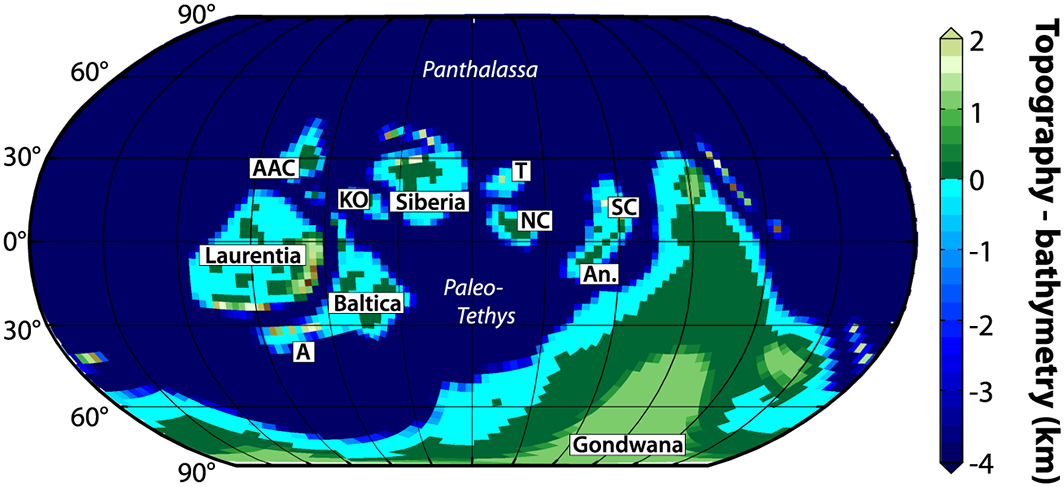story by Helen Hill


Late Ordovician-early Silurian continental reconstruction interpolated on the MITgcm cubed sphere grid: AAC: Arctic Alaska-Chukotka, KO: Kolyma-Omolon, A: Avalonia, T: Tarim, NC: North China, SC: South China, An: Annamia. Ocean names are in italics – image courtesy A. Pohl
This month we spotlight new work by Alexandre Pohl and co-authors from France and the UK concerning ocean circulation in deep geological time. Pohl et al used a coupled ocean-atmosphere setup of the MITgcm to investigate the relationships between climate and marine biogeochemistry during the Late Ordovician (445 million years ago).
The Ordovician-Silurian transition (∼ 455-430 Ma) is characterized by repeated climatic perturbations, concomitant with major changes in the global oceanic redox state best exemplified by the periodic deposition of black shales. The relationship between the climatic evolution and the oceanic redox cycles remains an area of active debate. The Climatic Significance of Late Ordovician-early Silurian Black Shales investigates the mechanisms responsible for the burial of organic carbon immediately before, during and right after the latest Ordovician Hirnantian (445-444 Ma) glacial peak, using MITgcm configured as an ocean-atmosphere general circulation model accounting for ocean biogeochemistry.
Comparing their results with recent sedimentological and geochemical data Pohl et al show that the late Katian time slice (∼ 445 Ma), typified by the deposition of black shales at tropical latitudes, represents an unperturbed oceanic state, with regional organic carbon burial driven by the surface primary productivity. During the Hirnantian, their experiments predict a global oxygenation event, in agreement with the disappearance of the black shales in the sedimentary record. The authors take this to suggest that deep-water burial of organic matter may not be a tenable triggering factor for the positive carbon excursion reported at that time.
The teams simulations indicate that the perturbation of the ocean circulation induced by the release of freshwater, in the context of the post-Hirnantian deglaciation, does not sustain over sufficiently long geological periods to cause the Rhuddanian (∼ 444 Ma) oceanic anoxic event. They further hypothesize the input of nutrients to the ocean, through increased continental weathering and the leaching of newly-exposed glaciogenic sediments, may instead constitute the dominant control on the spread of anoxia in the early Silurian.
Lead author Alexandre Pohl says “We adopted the MITgcm for several reasons: first, because the ocean model is up-to-date, second, because the CS32 grid provided an interesting compromise between spatial resolution and required computer resources and finally because the cubed-sphere setup allowed us to accurately simulate polar oceans, which is crucial in the Ordovician when the Northern Hemisphere was virtually entirely oceanic. In summary we wanted a super-flexible climate model, and MITgcm gave us just that.”
To find out more about this work contact Alexandre.
About the Researchers:
Alexandre Pohl is a paleoclimate modeler, trying to understand how and why Earth’s climate changed in the past, especially in deep time during pre-Cenozoic times. He is currently a postdoctoral researcher at CEREGE (Aix en Provence, France). His co-authors are Yannick Donnadieu at CEREGE; Guillaume Le Hir at the Institut de Physique du Globe de Paris (IPGP), Paris, France; and David Ferreira a Lecturer in the Department of Meteorology at the University of Reading, United Kingdom. Pohl says “I am actually a beginner with MITgcm. I learned to use it during my PhD thesis at LSCE, and this is my first publication with this model. Fortunately, I benefited from David [Ferreira]’s help throughout this project and ready helpful feedbacks provided on the MITgcm mailing list. Since then, I have adopted MITgcm as my primary modeling tool, and am using it for many studies and projects currently underway.” When he isn’t hard at work doing paleoceanography, Pohl’s go-to activities are generally outdoors, in particular mountain biking.
Alexandre Pohl is a paleoclimate modeler, trying to understand how and why Earth’s climate changed in the past, especially in deep time during pre-Cenozoic times. He is currently a postdoctoral researcher at CEREGE (Aix en Provence, France). His co-authors are Yannick Donnadieu at CEREGE; Guillaume Le Hir at the Institut de Physique du Globe de Paris (IPGP), Paris, France; and David Ferreira a Lecturer in the Department of Meteorology at the University of Reading, United Kingd
This Month’s Featured Publication
- Pohl, A., Y. Donnadieu, G. Le Hir, D. Ferreira (2017), The climatic significance of Late Ordovician-early Silurian black shales, Paleoceanography, accepted manuscript online April 13, 2017, doi: 10.1002/2016PA003064
Other New Publications this Month
Balwada, Dhruv (2016), Circulation and stirring by ocean turbulence, PhD Thesis Florida State Univ., pdf
Amanda R. Fay, Galen A. McKinley (2017), Correlations of surface ocean pCO2 to satellite chlorophyll on monthly to interannual timescales, Global Biogeochemical Cycles, doi: 10.1002/2016GB005563
Brian Green and John Marshall (2017), Coupling of Trade Winds with Ocean Circulation Damps ITCZ Shifts, Journal of Climate, doi: 10.1175/JCLI-D-16-0818.1
Jordi Isern-Fontanet, Joaquim Ballabrera-Poy, Antonio Turiel, and Emilio García-Ladona (2017), Retrieval and assimilation of velocities at the ocean surface, Nonlin. Processes Geophys., doi: 10.5194/npg-2017-14
Polona Itkin and Thomas Krumpen (2017), Winter sea ice export from the Laptev Sea preconditions the local summer sea ice cover, The Cryosphere Discuss., doi: 10.5194/tc-2017-28
Jennifer King, Gunnar Spreen, Sebastian Gerland, Christian Haas, Stefan Hendricks, Lars Kaleschke, Caixin Wang (2017), Sea-ice thickness from field measurements in the northwestern Barents Sea, Journal of Geophysical Research – Oceans, doi: 10.1002/2016JC012199
Inga. M. Koszalka, Thomas W.N. Haine, Marcello G. Magaldic (2017), Mesoscale mixing of the Denmark Strait Overflow in the Irminger Basin, Ocean Modelling, Volume 112, pp. 90–98, doi: 10.1016/j.ocemod.2017.03.001
Sachiko Mohanty, A. D. Rao, Himansu Pradhan (2017), Effect of seasonal and cyclonic winds on internal tides over the Bay of Bengal, Nat Hazards, doi: 10.1007/s11069-017-2811-9
Gavin J. Pringle, Daniel C. Jones, Sudipta Goswami, Sri Hari Krishna Narayanan, and Daniel Goldberg, Antoine Renaud, Antoine Venaille, and Freddy (2016), Providing the ARCHER community with adjoint modelling tools for high-performance oceanographic and cryospheric computation pdf
Antoine Renaud, Antoine Venaille, and Freddy Bouchet (2017), Impact of viscous boundary layers on the emission of lee-waves, Geophysical Research Abstracts, Vol. 19, EGU2017-18871, EGU General Assembly 2017 pdf
G. G. Sutyrin and T. Radko (2017), The fate of pancake vortices, Physics of Fluids, 29, 031701, doi: 10.1063/1.4977975
K.D. Stewart, A.McC. Hogg, S.M. Griffies, A.P. Heerdegen, M.L. Ward, P. Spenc, M.H. England (2017), Vertical resolution of baroclinic modes in global ocean models, Ocean Modelling, Volume 113, May 2017, pp. 50–65, doi: 10.1016/j.ocemod.2017.03.012
John Turner, Andrew Orr, G. Hilmar Gudmundsson, Adrian Jenkins, Robert G. Bingham, Claus-Dieter Hillenbrand, Thomas J. Bracegirdle (2017), Atmosphere-ocean-ice interactions in the Amundsen Sea Embayment, West Antarctica, Reviews of Geophysics, doi: 10.1002/2016RG000532
Rike Völpel, André Paul, Annegret Krandick, Stefan Mulitza and Michael Schulz (2017), Stable water isotopes in the MITgcm (checkpoint 64w), Geosci. Model Dev., doi: 10.5194/gmd-2017-7
Do you have news about research using MITgcm? We are looking for contributions to these pages. If you have an interesting MITgcm project (ocean, atmosphere, sea-ice, physics, biology or otherwise) that you want to tell people about, get in touch. To make a post, contact Helen

